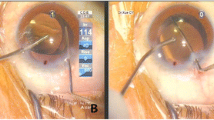Abstract
Efficacy and safety of blue-light-filtering acrylic IOL (HMY) were assessed and proven from 3 months to 1 year of postoperative follow-up in a clinical study performed on 80 eyes of 45 patients. Postoperative corrected visual acuity of all the eyes was 6/12 or better and 78.8% of them achieved higher than 6/6. The rate of mean corneal endothelial cell density decrease stood at 5.0%. Mild complciations were observed, but none were serious.
Similar content being viewed by others
References
Leaming DV. Practice styles and preferences of ASCRS members—2003 survey. J Cataract Refract Surg. 2004;30:892–900.
Oshika T, Suzuki Y, Kizaki H, et al. Two year clinical study of a soft acrylic intraocular lens. J Cataract Refract Surg. 1996;22: 104–109.
Niwa K, Yoshino Y, Okuyama F, et al. Effects of tinted intraocular lens on contrast sensitivity. Ophthalmic Physiol Opt. 1996;16: 297–302.
Yuan Z, Reinach P, Yuan J. Contrast sensitivity and color vision with a yellow intraocular lens. Am J Ophthalmol. 2004;138: 138–140.
Miyake K, Ichihashi S, Shibuya Y, et al. Blood-retinal barrier and autofluorescence of the posterior polar retina in long-standing pseudophakia. J Cataract Refract Surg. 1999;25:891–897.
Sparrow JR, Miller AS, Zhou J. Blue light-absorbing intraocular lens and retinal pigment epithelium protection in vitro. J Cataract Refract Surg. 2004;30:873–878.
Neuhann TH, Weber S. Clinical 12-month outcome with the foldable, hydrophobic acrylic lens AMO AR40NB. Klin Monatsbl Augenheilkd. 1999;215:329–333.
Prosdocimo G, Tassinari G, Sala M, et al. Posterior capsule opacification after phacoemulsification: silicone CeeOn Edge versus acrylate AcrySof intraocular lens. J Cataract Refract Surg. 2003;29:1551–1555.
Miyata A, Uchida N, Nakajima K, et al. Clinical and experimental observation of glistening in acrylic intraocular lenses. Jpn J Opthalmol. 2001;45:564–569.
Ishida M, Yanashima K, Miwa M, et al. Influence of the yellowtinted intraocular lens on spectral sensitivity. [Japanese] Nippon Ganka Gakkai Zasshi. 1994;98:192–196.
Author information
Authors and Affiliations
Corresponding author
Additional information
Disclosure The authors have stated that they do not have a significant financial interest or other relationship with any product manufacturer or provider of, services discussed in this article. The authors also do not discuss the use of off-label products, which includes unlabeled, unapproved, or investigative products or devices.
Rights and permissions
About this article
Cite this article
Hibino, T., Shimomura, Y., Matsumoto, C. et al. Clinical evaluation of blue-light blocker foldable acrylic IOL (HMY). Ann Ophthalmol 38, 311–316 (2006). https://doi.org/10.1007/BF02697213
Received:
Accepted:
Issue Date:
DOI: https://doi.org/10.1007/BF02697213




